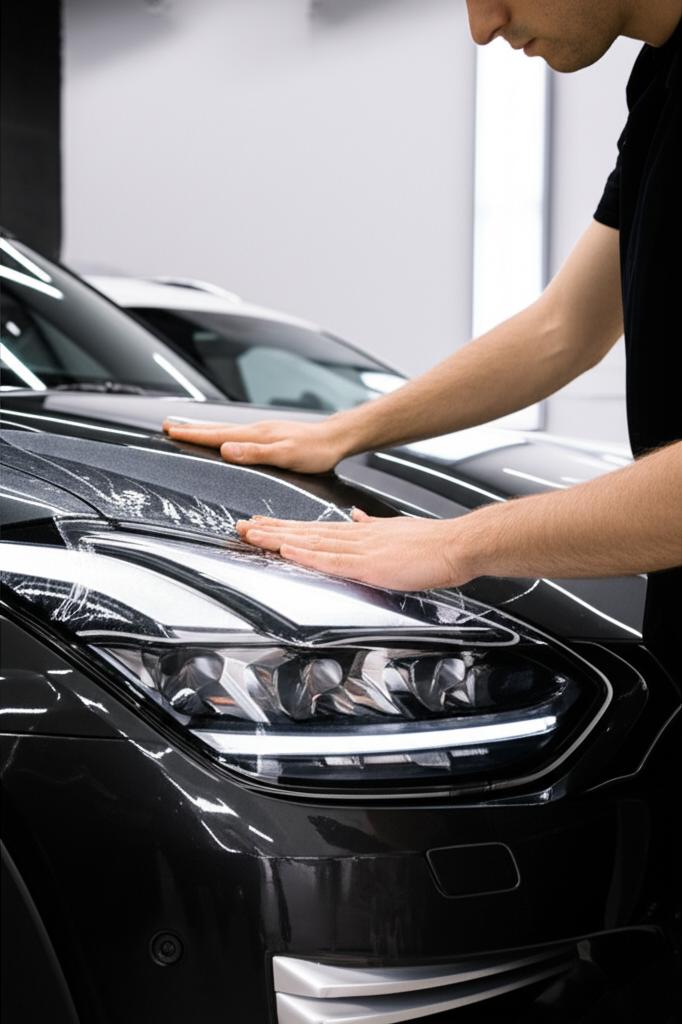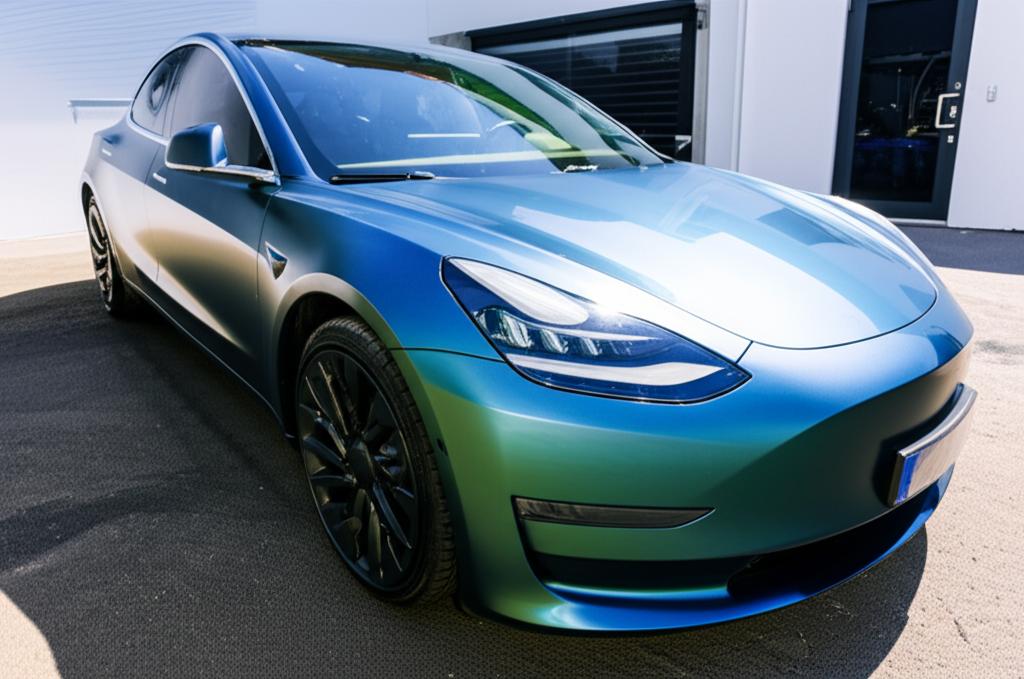You love your electric vehicle. You chose it not just for its efficiency and performance, but also because it aligns with your values – a step towards a cleaner, more sustainable future for Thailand. You cherish that quiet ride, the instant torque, and the feeling of driving a car that’s ahead of its time.
But let’s be honest. Owning a car in Thailand, even a state-of-the-art EV, comes with its unique challenges. The relentless tropical sun, the intense heat, sudden downpours, and let’s not forget the occasional road debris or unexpected scratch in a crowded parking lot. These aren’t just minor annoyances; they are constant threats to your vehicle’s pristine finish and long-term value.
As environmentally conscious individuals, you understand the importance of preserving your investments and minimizing waste. A damaged, faded, or scratched car might require expensive repainting, which isn’t exactly the most eco-friendly process. So, how do you protect your valuable EV from the harsh realities of Thai roads and weather, ensuring it looks as good as the day you drove it off the lot for years to come?
Many EV owners in Thailand have already found the answer, often after learning the hard way. It’s not just a trend; it’s become an unspoken consensus: protecting your EV’s paintwork with high-quality TPU film.

Consider the story of Khun Somchai, an early adopter of a popular electric sedan in Bangkok. Khun Somchai was initially hesitant about adding anything to his car’s sleek design. He thought regular washing and waxing would be enough. However, after just a year, he started noticing subtle swirl marks from washing, small stone chips on the hood and bumper from highway driving, and a slight hazing on the paint exposed directly to the sun.
“I was so careful,” Khun Somchai shared. “But the heat and the dust… they are just too much. I saw other EVs around looking so new, even older ones, and I wondered why mine was showing wear so quickly.”
After researching and talking to other EV owners, Khun Somchai decided to invest in a full body wrap with premium TPU film. The process involved meticulously cleaning the car, precisely cutting the film to fit every panel, and skillfully applying it. It took a couple of days, but the transformation was remarkable.
His car’s paint regained its deep gloss, now protected by a virtually invisible shield. The small imperfections were less noticeable under the film, and he immediately felt a sense of relief knowing his car was now safeguarded against future damage. “It’s like giving my car a second skin,” he said with a smile. “Now I don’t worry about every little thing on the road. And knowing it will keep my car looking new for years feels right, especially for an EV which I plan to keep for a long time.”

Understanding Your Options: Why TPU Stands Out
When it comes to protecting your car’s paint, there are various options, but not all are created equal, especially for the demands of the Thai climate and the value of an EV. Let’s look at why Thermoplastic Polyurethane (TPU) film, often referred to as Paint Protection Film (PPF), has become the preferred choice.
Unlike traditional vinyl wraps, which are primarily for color change or graphics and offer minimal impact protection, TPU film is specifically engineered for paint protection. It’s a much thicker, more durable, and flexible material designed to absorb the impact of stones, resist scratches, and protect against environmental contaminants like bird droppings, insect acids, and tree sap.
Here’s a simple comparison:
| Feature | TPU Film (PPF) | Standard Vinyl Wrap | Wax/Sealant |
|---|---|---|---|
| Primary Purpose | Paint Protection (Impact, Scratches, UV, Chemicals) | Color Change, Graphics, Light Protection | Temporary Gloss, Minor UV/Water Protection |
| Material | Thermoplastic Polyurethane | Polyvinyl Chloride (PVC) | Natural/Synthetic Compounds |
| Thickness | Significantly thicker (often 6-10 mil) | Thinner (often 2-4 mil) | Microscopic layer |
| Protection Level | High (Against chips, scratches, abrasions, harsh chemicals) | Low (Against minor scuffs, no impact protection) | Very Low (Against light contaminants, no physical protection) |
| Self-Healing | Yes (Minor scratches disappear with heat) | No | No |
| Durability/Lifespan | Long (Typically 5-10+ years) | Medium (Typically 3-7 years, can fade/crack in harsh sun) | Short (Weeks to months) |
| Appearance | High clarity, enhances gloss, virtually invisible | Can alter finish (matte, satin, gloss), may show texture | Enhances existing gloss temporarily |
| Maintenance | Easy to clean, resistant to staining | Requires specific cleaning products, can stain | Frequent reapplication needed |
| Cost (Initial) | Highest | Medium | Lowest |
| Cost (Long-Term) | Lower (Protects resale value, avoids repaints) | Medium (May need replacement sooner, less protection) | Highest (Frequent reapplication, no protection against damage) |
| Environmental Aspect | Long lifespan reduces need for repaints/replacement, protects investment | Shorter lifespan, less protective, less sustainable | Frequent use of products, no long-term protection |
For EV owners who value longevity and preserving their vehicle’s condition, the long-term benefits and superior protection of TPU film make the initial investment worthwhile. It’s not just about keeping your car looking new; it’s about protecting a significant asset and aligning with a mindset of sustainable ownership by extending the life and appearance of your vehicle.
What Thai EV Owners Are Saying
The sentiment among EV owners who have chosen TPU film is overwhelmingly positive. Here are a few thoughts we’ve gathered:
Khun Anya, driving an electric SUV: “I hesitated because of the cost, but my friend who didn’t wrap their car got a nasty scratch in a parking lot that needed touch-up. I decided it was better to prevent than repair. Now, after a year, my car still looks like it just left the showroom. The peace of mind is priceless, especially with kids and shopping bags around the car!”
Khun Bordin, owner of an electric pickup truck: “Using my electric truck for work means it faces tough conditions. Dirt roads, branches, loading and unloading… I knew the paint wouldn’t last unprotected. The TPU film has been amazing. It takes the hits, and a quick wash makes it look perfect again. It’s tough, just like the truck needs to be.”
Khun Chayapa, daily commuter in an electric hatchback: “Living in the city, my car is constantly exposed to traffic fumes, dust, and the sun. I chose TPU not just for scratches but for UV protection. I saw how the sun faded the plastic trim on my previous car. My EV’s paint still looks vibrant and new. It feels good knowing I’m protecting my investment and keeping it looking its best.”
These stories reflect a common experience: initial consideration of the cost, followed by the realization of the value in protection, durability, and peace of mind that TPU film provides in the challenging Thai environment.
Ready to Protect Your EV?
If you’re an EV owner in Thailand and you’re concerned about maintaining your vehicle’s appearance and value, joining the ranks of protected cars is a decision you won’t regret. Protecting your paint with high-quality TPU film is an investment in your car’s future and a reflection of your commitment to preserving your assets.
Choosing the right film and installer is crucial. Look for experienced professionals who understand the nuances of applying film to EVs, ensuring a seamless finish and maximum protection.
📱 Want to learn more about car wrap & paint protection?
Feel free to reach us on LINE:

🌐 Official Website: https://tpuwraps.com
Frequently Asked Questions About TPU Film for EVs in Thailand
- Q: Will TPU film affect my EV’s range?
- A: No, the weight of TPU film is negligible and will not have any measurable impact on your EV’s driving range or efficiency.
- Q: How long does TPU film last in Thailand’s climate?
- A: High-quality TPU films are designed to withstand harsh UV rays and heat. With proper care, they can last anywhere from 5 to 10 years or even longer, depending on the film quality and exposure conditions.
- Q: Is TPU film visible on the car?
- A: Premium TPU films are designed to be optically clear and virtually invisible once applied correctly. They enhance the paint’s gloss and depth without altering its color or texture.
- Q: Can TPU film be removed?
- A: Yes, TPU film can be safely removed by a professional installer without damaging the underlying factory paint, even after many years.
- Q: Is wrapping the entire car necessary, or can I do just certain parts?
- A: You can choose to protect specific high-impact areas like the front bumper, hood, fenders, side mirrors, and rocker panels. However, for comprehensive protection against UV, environmental contaminants, and uniform aging, a full body wrap is recommended and is the “consensus” approach for maximum benefit.
Protect Your Investment, Preserve Your Values
For environmentally conscious EV owners in Thailand, choosing TPU film is more than just an accessory; it’s a practical necessity and a smart investment. It protects your vehicle from the unique challenges of the Thai environment, maintains its aesthetic appeal and resale value, and aligns with a sustainable approach to car ownership by extending the life of the paintwork and reducing the need for potentially harmful repairs or repaints.
Join the growing number of Thai EV owners who have found peace of mind and lasting beauty through the protection of TPU film. It’s a decision that protects your car, your investment, and reflects your commitment to a cleaner future.
